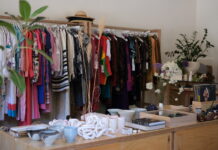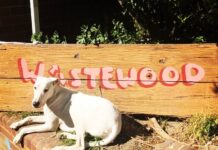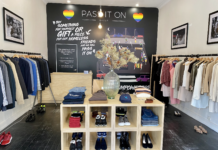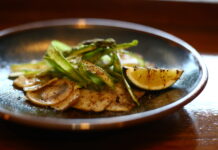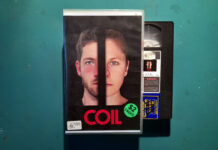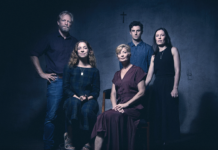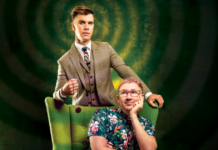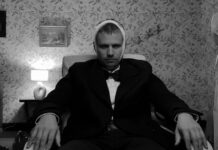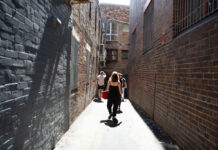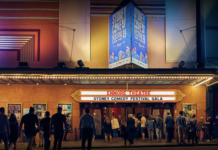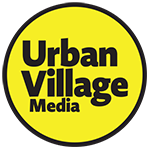The big green building on Elizabeth Street, opposite Central, has been an artists’ centre for three decades or more. In a city over run with development and where the dollar rules, it is a unique haven for creative people to work, interact and show their work. Lachlan Colquhoun ventures through the maze of graffiti covered corridors and takes the rickety lift to meet two of Hibernian’s longtime occupants.
Ariel Sexton-Shaw is in the Shadow Lodge, her studio and gallery on the fifth floor at Hibernian.
The painter, sculptor and jeweller, who is also on a hiatus from her rock n’roll career, is talking about a recent trip to Bali, where she painted some spontaneous murals.

“I did what I thought were two mermaids holding hands, with a bit of a yoga thing, and I did them with big long serpent tails,” she says.
“And the locals all started freaking out because there was a local legend about a Snake Lady who was a predator who would eat people. So they were terrified, and I had to paint over it and make Snake Lady into Fish Lady.”
Religious iconography and references abound in her work. A massive canvas, a triptych which is her current work in progress, dominates the room.
Light emanates from a “Fire Goddess” figure to illuminate the canvas. It hints at Hindu imagery, although she says it is inspired by Hieronymous Bosch’s Renaissance masterpiece the Garden of Earthly Delights.
“I’m challenging myself to create this hypersexual, hyperpassionate and super elemental major work which is worlds within worlds within worlds,” she says.
“I’m really going to take my time on this one. There are clusters of miniature figures I want to detail, and when I get to that point I can roll up the canvas and take it to Bali and work on it there.”
While she is there, the Shadow Lodge will remain, and morph from her personal studio into a gallery where other artists can also show their work.
The idea is that Sexton Shaw will move between Sydney and Bali, working on the painting and also becoming more involved with her “micro sculpture” and jewellery, while still maintaining the Shadow Lodge as a going concern.
It’s the culmination of about 10 years she has spent at Hibernian in a number of different studios, a period spent working next to and collaborating with artists from various disciplines, some of them who have gone onto become celebrated while others remain unknown.
“This place has always been a place for artists and musicians and poets,” says Sexton Shaw.
“So many people have been creating here its like the energy of creation has soaked into the walls and when you are here you work faster and you work more.
“Maybe it’s because there is such an internal community, but when you are here so much you don’t need to leave and interact so much with the rest of world.”
On level one, Jeff Hamilton has probably been at Hibernian House for longer than anyone.
He moved in at the time of the Sydney Olympics in 2000, setting up his stained glass studio in a corner room facing Elizabeth Street and Central.
A light box positioned towards the street can be seen from the road and gives Hibernian House a signature night time look. Someone on FBI Radio, he says, just used to call it “the Stained Glass Building.”
While indie rock band the Preatures tune up and jam in the next studio on what could be a new song, Hamilton gives his take on Hibernian.
“These kinds of places are essential and they are lifeblood of the city,” he says.
“It is in the nature of creative people and creative people that people are devoted to what they do, and they do it even if they don’t earn so much income.
“So you need relatively cheap rental space available to make that happen and for people to create ground breaking work, and it has to be versatile. You need to be able to screw something into a wall, not be minding the polished floor all the time.”
Hamilton recalls a time when the city had a number of other artist spaces similar to Hibernian, but one by one they’ve been claimed by the march of gentrification.
On the positive side, some of Hibernian’s tenants have moved out and taken their creativity with them.
Jazz club 505 on Cleveland Street, for example, came out of studio 505 at Hibernian, and Redfern’s 107 Projects was previously right next to Hamilton’s studio on level one before moving, coincidentally, to 107 Redfern Street.
“They had Knot Gallery here and for five years or so it was a very powerful and creative group, and I really got caught up in that enthusiasm,” says Hamilton.
“But that is Hibernian. There’s always a lot of interaction between the people on the various level and a lot of parties, in between all the hard work.”
Like Ariel Sexton-Shaw, religious iconography is also central to Hamilton’s work but in a very different way.
He works as a stained glass artist and his work adorns around 20 churches and religious buildings around Australia, and the studio is now full of work in progress for the East Maitland Anglican Church.
“I’m taking a lot of Renaissance painting and using that as my inspiration,” he says.
His own work is more secular. The current project is a “baker’s dozen” of 13 A4 glass paintings on glass of “World Heroes.”
It is an ironic title, as the one he has just completed is of Syrian dictator Bashir al Assad.
Given that it took him four days to move all his equipment into Hibernian House 18 years ago, Hamilton is loathe to leave, and is optimistic he can stay on for a while yet.
“As far as I know it will continue for the foreseeable future,” he says.
“They painted the façade in 2016 and fixed up the goods lift, and that’s getting a lot of use because there are new tenants from the rag trade.
“So it’s a going concern. And its not just important for me that it continues, I’d say it was important for Sydney too.”

